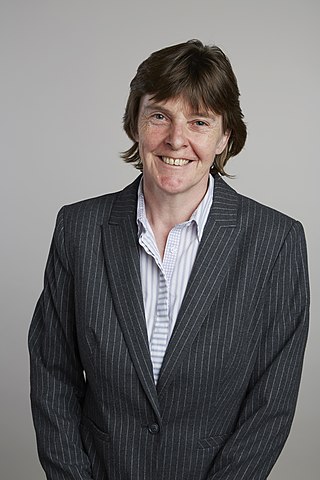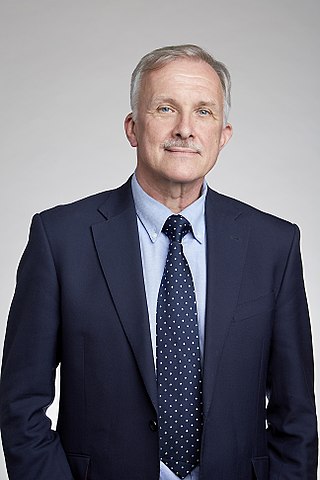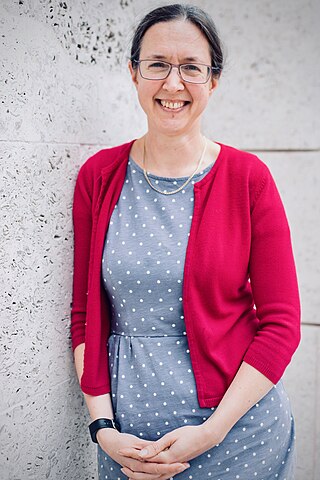
John "Shôn" Eirwyn Ffowcs Williams (1935–2020) was Emeritus Rank Professor of Engineering at the University of Cambridge and a former Master of Emmanuel College, Cambridge (1996–2002). He may be best known for his contributions to aeroacoustics, in particular for his work on Concorde. Together with one of his students, David Hawkings, he introduced the far-field integration method in computational aeroacoustics based on Lighthill's acoustic analogy, known as the Ffowcs Williams–Hawkings analogy.

Dame Kay Elizabeth Davies is a British geneticist. She is Dr Lee's Professor of Anatomy at the University of Oxford and a Fellow of Hertford College, Oxford. She is director of the Medical Research Council (MRC) functional genetics unit, a governor of the Wellcome Trust, a director of the Oxford Centre for Gene Function, and a patron and Senior Member of Oxford University Scientific Society. Her research group has an international reputation for work on Duchenne muscular dystrophy (DMD). In the 1980s, she developed a test which allowed for the screening of foetuses whose mothers have a high risk of carrying DMD.

Christopher Michael Bishop is a British computer scientist. He is a Microsoft Technical Fellow and Director of Microsoft Research AI4Science. He is also Honorary Professor of Computer Science at the University of Edinburgh, and a Fellow of Darwin College, Cambridge. Chris was a founding member of the UK AI Council, and in 2019 he was appointed to the Prime Minister’s Council for Science and Technology.
Dame Lynn Faith Gladden is the Shell Professor of Chemical Engineering at the University of Cambridge. She served as Pro-vice-chancellor for research from 2010 to 2016.

Sir Colin John Humphreys, is a British physicist and Christian apologist. He is the Professor of Materials Science at Queen Mary University of London.
James Julian Bennett Jack is a New Zealand physiologist.
Philip Candelas, is a British physicist and mathematician. After 20 years at the University of Texas at Austin, he served as Rouse Ball Professor of Mathematics at the University of Oxford until 2020 and is a Fellow of Wadham College, Oxford.

Julia Mary Yeomans is a British theoretical physicist active in the fields of soft condensed matter and biological physics. She has served as Professor of Physics at the University of Oxford since 2002.

Alison Mary Etheridge is Professor of Probability and former Head of the Department of Statistics, University of Oxford. Etheridge is a fellow of Magdalen College, Oxford.

Sir John Michael Brady is an emeritus professor of oncological imaging at the University of Oxford. He has been a Fellow of Keble College, Oxford, since 1985 and was elected a foreign associate member of the French Academy of Sciences in 2015. He was formerly BP Professor of Information Engineering at Oxford from 1985 to 2010 and a senior research scientist in the MIT Computer Science and Artificial Intelligence Laboratory (CSAIL) in Cambridge, Massachusetts, from 1980 to 1985.

David William Hight is a senior consultant at the Geotechnical Consulting Group, a company providing high-level expertise in the field of geotechnical engineering and well known for bridging the gap between research and engineering practice.

(Edith) Yvonne JonesFLSW is director of the Cancer Research UK Receptor Structure Research Group at the University of Oxford and a Fellow of Jesus College, Oxford. She is widely known for her research on the molecular biology of cell surface receptors and signalling complexes.
Anne Neville was the Royal Academy of Engineering Chair in emerging technologies and Professor of Tribology and Surface Engineering at the University of Leeds.

Anne Jacqueline Ridley is professor of Cell Biology and Head of School for Cellular and Molecular Medicine at the University of Bristol. She was previously a professor at King's College London.

(James) Roy TaylorFREng is Professor of Ultrafast Physics and Technology at Imperial College London.

Katherine Mary Blundell is a Professor of Astrophysics at the University of Oxford and a supernumerary research fellow at St John's College, Oxford. Previously, she held a Royal Society University Research Fellowship, and fellowships from the Royal Commission for the Exhibition of 1851 and Balliol College, Oxford.
Eileen M. A. Harkin-Jones is the Bombardier Aerospace-Royal Academy of Engineering professor of composites engineering at the Ulster University.

Rachel Angharad Oliver is a Professor of Materials Science at the University of Cambridge and a fellow of Robinson College, Cambridge. She works on characterisation techniques for gallium nitride materials for dark-emitting diodes and laser diodes.
Sarah Katherine Spurgeon is the Head of Department of Electronic and Electrical Engineering at University College London. She served as President of the Engineering Professors' Council from 2017 to 2019. She has previously served as Head of the Department of Engineering at both the University of Leicester and University of Kent.
Julia A. Schnabel is Professor in Computational Imaging and AI in Medicine at Technische Universität München, Director of the Institute of Machine Learning in Biomedical Imaging at Helmholtz Zentrum München, and Chair of Computational Imaging at the School of Biomedical Engineering and Imaging Sciences at King's College London. Previously, she was Associate Professor in Engineering Science at University of Oxford where she became Full Professor of Engineering Science in 2014.













